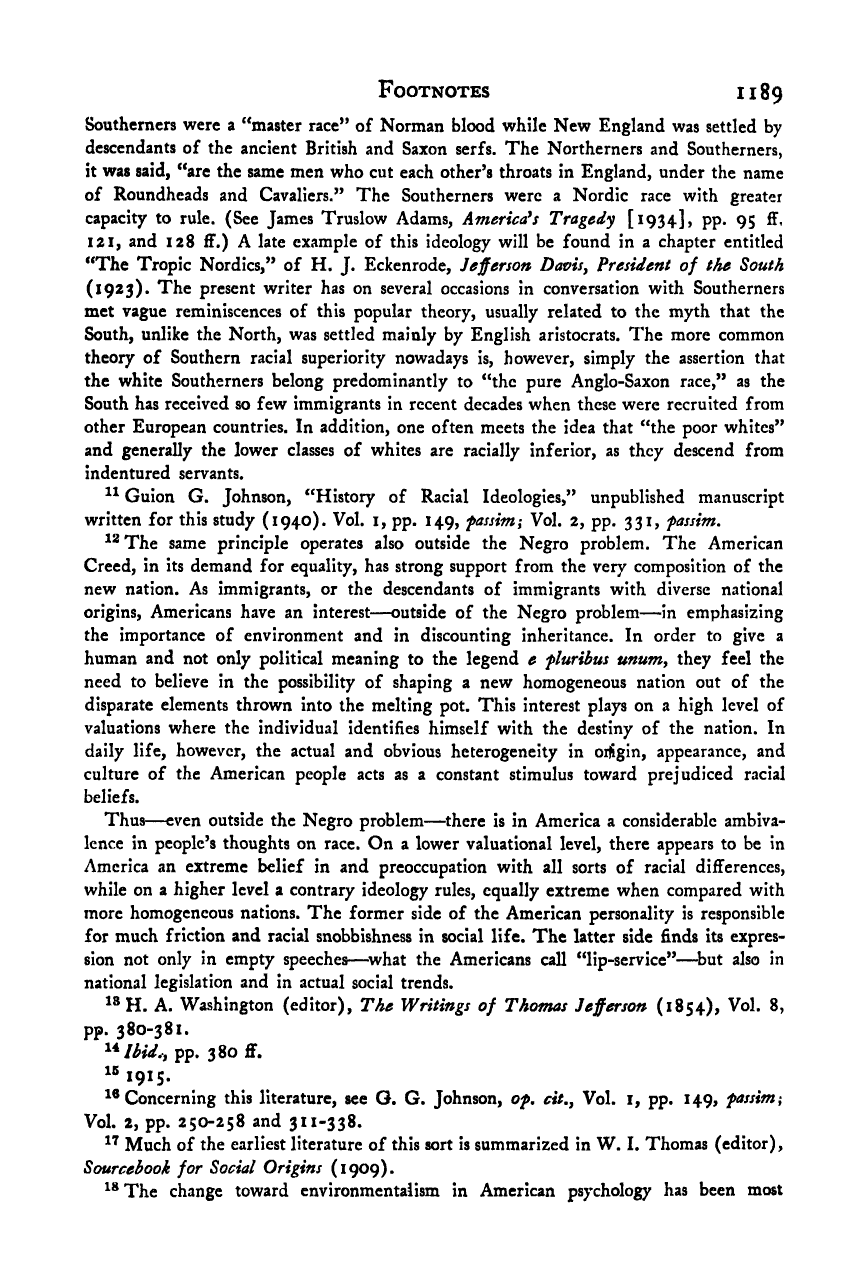Note: Gunnar Myrdal died in 1987, less than 70 years ago. Therefore, this work is protected by copyright, restricting your legal rights to reproduce it. However, you are welcome to view it on screen, as you do now. Read more about copyright.
Full resolution (TIFF) - On this page / på denna sida - Footnotes - Chapter 4

<< prev. page << föreg. sida << >> nästa sida >> next page >>
Below is the raw OCR text
from the above scanned image.
Do you see an error? Proofread the page now!
Här nedan syns maskintolkade texten från faksimilbilden ovan.
Ser du något fel? Korrekturläs sidan nu!
This page has never been proofread. / Denna sida har aldrig korrekturlästs.
Footnotes 1189
Southerners were a “master race” of Norman blood while New England was settled by
descendants of the ancient British and Saxon serfs. The Northerners and Southerners,
it was said, “are the same men who cut each other’s throats in England, under the name
of Roundheads and Cavaliers.” The Southerners were a Nordic race with greater
capacity to rule. (See James Truslow Adams, Americans Tragedy [1934], pp. 95 ff,
1 2 1, and 128 ff.) A late example of this ideology will be found in a chapter entitled
“The Tropic Nordics,” of H. J. Eckenrode, Jeferson Davisy President of the South
(1925). The present writer has on several occasions in conversation with Southerners
met vague reminiscences of this popular theory, usually related to the myth that the
South, unlike the North, was settled mainly by English aristocrats. The more common
theory of Southern racial superiority nowadays is, however, simply the assertion that
the white Southerners belong predominantly to “the pure Anglo-Saxon race,” as the
South has received so few immigrants in recent decades when these were recruited from
other European countries. In addition, one often meets the idea that “the poor whites”
and generally the lower classes of whites are racially inferior, as they descend from
indentured servants.
Guion G. Johnson, “History of Racial Ideologies,” unpublished manuscript
written for this study (1940). Vol. i, pp. 149, fassim; Vol. 2, pp. 331, fassim,
^^The same principle operates also outside the Negro problem. The American
Creed, in its demand for equality, has strong support from the very composition of the
new nation. As immigrants, or the descendants of immigrants with diverse national
origins, Americans have an interest—outside of the Negro problem—in emphasizing
the importance of environment and in discounting inheritance. In order to give a
human and not only political meaning to the legend e fluribus ununiy they feel the
need to believe in the possibility of shaping a new homogeneous nation out of the
disparate elements thrown into the melting pot. This interest plays on a high level of
valuations where the individual identifies himself with the destiny of the nation. In
daily life, however, the actual and obvious heterogeneity in oiligin, appearance, and
culture of the American people acts as a constant stimulus toward prejudiced racial
beliefs.
Thus—even outside the Negro problem—^there is in America a considerable ambiva-
lence in people’s thoughts on race. On a lower valuational level, there appears to be in
America an extreme belief in and preoccupation with all sorts of racial differences,
while on a higher level a contrary ideology rules, equally extreme when compared with
more homogeneous nations. The former side of the American personality is responsible
for much friction and racial snobbishness in social life. The latter side finds its expres-
sion not only in empty speeches—^what the Americans call “lip-service”—^but also in
national legislation and in actual social trends.
H. A. Washington (editor). The Writings of Thomas Jefferson (1854), Vol. 8,
pp. 380-381.
Ibid.
y
pp. 380 ff.
«I9IS.
Concerning this literature, see G. G. Johnson, of. cit., Vol. i, pp. 149, fassim;
Vol. 2, pp. 250-258 and 311-338.
Much of the earliest literature of this sort is summarized in W. I. Thomas (editor).
Sourcebook for Social Origins (1909).
The change toward environmentalism in American psychology has been most
<< prev. page << föreg. sida << >> nästa sida >> next page >>